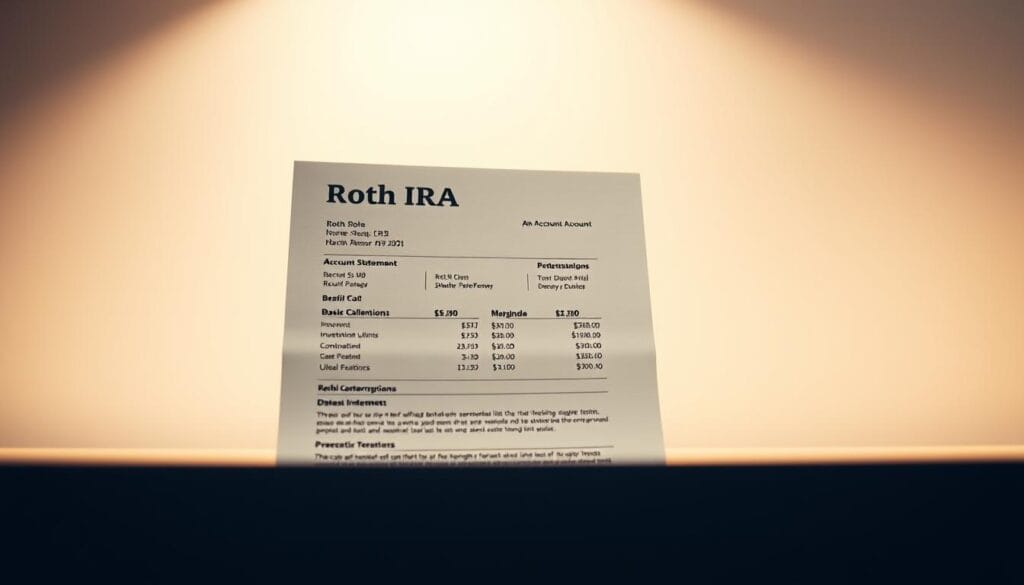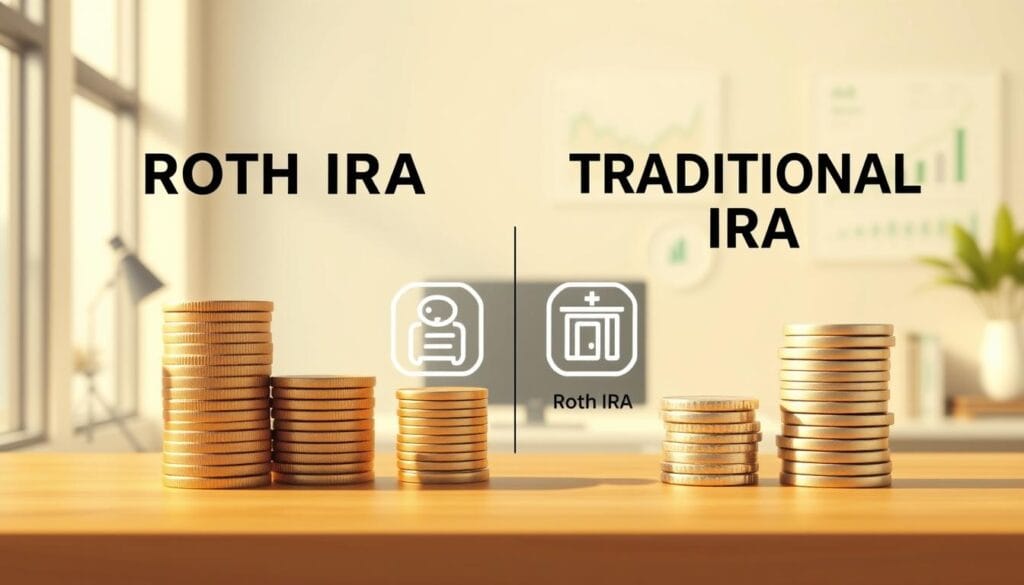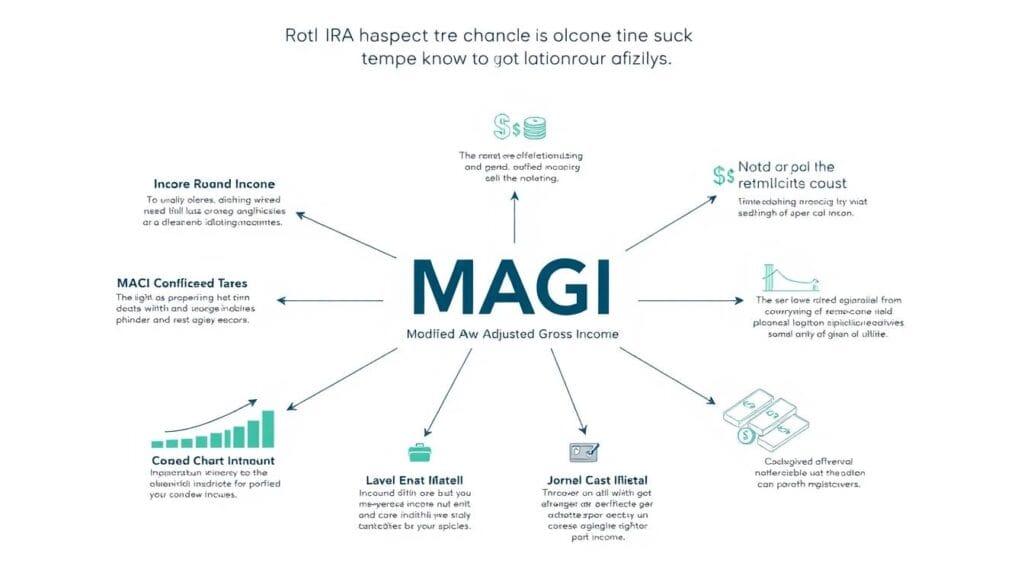Surprising fact: nearly one in five savers could be blocked from contributing this year because their modified adjusted gross income exceeds the limit.
This guide shows how a Roth account works: you fund it with after-tax money, let earnings grow tax-free, and take qualified withdrawals tax-free after age 59½ if the account has been open five years.
We’ll compare that model to a traditional IRA on taxes, eligibility, withdrawals, and long-term benefits. You’ll see 2025 figures for contribution caps and the MAGI phase-outs so the numbers are practical and current.
Expect clear rules on income limits, the five-year clock, and age milestones that affect access to funds. Understanding account structure matters: choices now can change lifetime tax exposure and give you flexibility across future income and investment decisions.
Key Takeaways
- Contributions use after-tax dollars; qualified growth and withdrawals can be tax-free.
- Income limits may prevent direct contributions for some filers in 2025.
- Compare tax treatment, RMD rules, and withdrawal options with traditional IRAs.
- 2025 contribution limits and MAGI thresholds make planning more concrete.
- Account choice affects long-term tax flexibility and how you manage investments.
What a Roth IRA is and why it matters right now

Put simply: you pay taxes now and qualified distributions later can come out tax-free. This account accepts after-tax contributions so potential earnings grow tax-free. That can lower your lifetime tax bill if you expect higher income down the road.
Key rules shape value: withdrawals of contributions are allowed anytime without taxes or penalties. Earnings are different — they become tax-free only after age 59½ and once the five-year clock has run. Starting that clock early gives your investments more time to qualify.
There are no required minimum distributions during an owner’s life, which simplifies planning and helps leave tax-free assets to heirs. Anyone with earned money can contribute at any age if income falls under the 2025 limits.
| Feature | What it means | Key year rule | 2025 note |
|---|---|---|---|
| Contributions | After-tax money, withdrawable anytime | No time limit | Income phase-outs start at $150,000 (single) |
| Earnings | Grow tax-free if qualified | Five-year holding + age 59½ | Phase-outs $236,000 (married filing jointly) |
| RMDs | None during owner’s lifetime | Not required | Helps legacy and tax planning |
Good information and disciplined investment choices matter. For provider options and to compare fees, see the top Roth IRA providers.
Roth IRA vs. Traditional IRA: Taxes, eligibility, and long-term implications

How you pay tax now versus later changes both near-term cash flow and future taxable income.
Tax treatment and long-term effects
After-tax contributions to a roth ira mean qualified growth and future withdrawals can be tax-free if you meet the five-year rule and are 59½ or older.
By contrast, a traditional ira often gives a current income tax deduction and tax-deferred growth, but withdrawals are taxed as ordinary income later.
Eligibility and deductibility
Roth iras impose income-based contribution caps tied to modified adjusted gross income. That limit can block direct contributions for high earners.
Traditional accounts accept contributions from anyone with earned income, but deductibility phases out at higher adjusted gross income if you or your spouse have a workplace retirement plan.
Withdrawals, distributions, and RMDs
Qualified withdrawals from roth iras are generally tax-free after age 59½ and the five-year holding period.
Traditional withdrawals increase taxable income and may affect tax bracket and Medicare premiums. Required minimum distributions begin at age 73 for traditional iras, which can raise taxable income in later years.
| Feature | Roth IRA | Traditional IRA | Implication |
|---|---|---|---|
| Contributions | After-tax, not deductible | May be deductible depending on AGI | Choose immediate deduction vs tax-free future withdrawals |
| Growth | Tax-free if qualified | Tax-deferred | Timing of taxes shifts liability |
| Withdrawals | Qualified withdrawals tax-free | Taxed as ordinary income | Impacts future income tax and bracket |
| RMDs | No RMDs for owner | RMDs start at age 73 | No forced distributions vs required taxable distributions |
Balanced approach: many savers split contributions between both account types to diversify tax outcomes and manage future income tax exposure. For provider options and beginner-friendly accounts, see top IRA accounts for beginners.
Eligibility and MAGI: How your adjusted gross income shapes your options

Knowing which income items count makes the difference between eligibility and being phased out.
Understanding modified adjusted gross income and adjusted gross income
Adjusted gross income starts with your total gross income and then subtracts specific deductions on your tax return. Modified adjusted gross adds certain items back for eligibility tests. That adjusted figure is what determines whether you can contribute directly to a roth ira in 2025.
2025 income thresholds and what they mean
Phase-outs begin at $150,000 for single filers and $236,000 for married filing jointly. If your magi sits inside those ranges, your contribution limit shrinks. Above the top cutoff, direct contributions are not allowed and you must consider alternatives.
| Item | Effect on eligibility | Action |
|---|---|---|
| MAGI under threshold | Full ability to contribute | Contribute directly |
| MAGI in phase-out | Reduced contribution amount | Calculate prorated limit |
| MAGI above range | No direct contribution | Consider backdoor or conversion |
Special income rules and planning tips
Minors with earned income may hold an account via a custodian; contributions can’t exceed their earned pay. A nonworking spouse can also contribute when filing jointly, based on total earned income.
Checklist: track income year-round, estimate magi before the contribution date, time bonuses or gains, and keep records of pay, contribution dates, and calculations. For tax-saving tactics, see top tax deduction strategies.
IRA contribution limits, deadlines, and funding methods

Know the exact contribution caps for 2025 so you can allocate money across accounts without exceeding limits.
2025 contribution limits are $7,000 if you are under age 50 and $8,000 if you are 50 or older. These limits apply across all iras combined, so funding both a roth ira and a traditional ira requires coordination.
Catch-up contributions add $1,000 for those 50 and up, letting older savers boost annual contributions. Timing deposits within the year can help maximize tax-advantaged growth and take full advantage of contribution limits.
Deadlines and restrictions
The contribution deadline is typically April 15 of the following year. You may designate a deposit for the prior year if it posts by that date.
Restrictions: contributions cannot exceed your earned income for the year. High income may limit deductibility for a traditional ira and may reduce or eliminate deductibility or direct eligibility for a roth ira.
Funding methods and recordkeeping
You can fund an account by a lump sum, periodic transfers, or employer rollovers. Automating transfers smooths cash flow and helps avoid missed contributions.
Rollovers and conversions are not regular contributions; they have different tax rules. Document contribution amounts, years, and earnings allocations so your provider reports correctly to the IRS.
| Item | 2025 amount | Notes |
|---|---|---|
| Under age 50 | $7,000 | Applies across all iras combined |
| Age 50 or older | $8,000 | Includes $1,000 catch-up |
| Deadline | April 15 (following year) | Can designate prior-year contribution |
| Requirement | Earned income minimum | Cannot exceed earned income for the year |
For provider choices and automatic transfer options, consider checking top workplace and individual account providers, including a comparison of 401(k) options for employees that can complement your IRA contribution strategy.
Withdrawals, the five-year rule, and penalties: what to know before taking money out

Knowing which dollars leave the account first can save you taxes and reduce penalties when you withdraw funds.
Ordering rules put contributions first, then conversion amounts, and finally earnings. That order affects whether a distribution triggers taxes or the 10% early penalty.
Qualified distributions are tax-free if taken after age 59½ and once the five-year holding period is met. Each conversion starts its own five-year clock, so track conversion years carefully to avoid surprise taxes.
Early withdrawals can incur a 10% federal penalty and taxes on earnings if the distribution is not qualified. Exceptions include disability, death, first-time home purchase (up to $10,000), qualified education expenses, certain medical costs, unemployment-related insurance premiums, IRS levy, qualified reservist pay, and a $5,000 birth/adoption allowance.
No required minimum distributions apply for owners of a roth account, while traditional iras begin RMDs at age 73 and can raise taxable income later.
Timing matters: wait until age and time tests are met when possible, and consult an advisor before complex early distributions or SEPP strategies. For broader income timing and benefit tips, see maximize your Social Security benefits.
Advanced planning with Roth IRAs: conversions, taxes, and investment strategy
Advanced moves like conversions and strategic asset placement can change how taxes affect your savings over decades.
Conversions and backdoor strategies
Conversions move pre-tax balances into a tax-free bucket. Since 2010 there is no income limit on conversions, so high earners often use a backdoor route: contribute to a traditional IRA and then convert to a roth ira.
Converting triggers income tax on pre-tax amounts. That means you must budget cash to pay taxes without dipping into invested funds.
Tax mechanics, MAGI, and NIIT
Qualified withdrawals from a roth ira do not add to MAGI, which can help avoid the Net Investment Income Tax. By contrast, distributions from traditional accounts raise MAGI and may trigger surtaxes.
Partial conversions in lower-income years smooth tax bills, help control tax brackets, and reduce future exposure to surtaxes.
Investment placement and tactical advice
Put higher-growth investments in the tax-free account to maximize compounding. Use conservative holdings in taxable or tax-deferred accounts to balance risk and taxes.
Watch the pro‑rata rule when you have multiple iras: conversions are prorated across pre-tax and after‑tax balances and can complicate taxes. Accurate records and current information are crucial.
Final tip: coordinate contributions, conversions, and distributions by age and income, and consult a tax advisor for multi-year conversion strategies and complex situations.
When a roth ira as retirement plan fits your needs—and when it may not
Deciding whether a tax-free growth account fits your needs depends on age, income outlook, and how long you can leave money invested.
Who benefits most
Younger savers with many years of time to compound see the biggest benefits. Paying tax now on contributions can lead to large tax-free distributions later.
Those who expect higher income or higher income tax rates in the future also gain. No required distributions during the owner’s life helps legacy-focused investors preserve tax-free assets for heirs.
When it may not be the best choice
If you need a current-year tax deduction to cover expenses, a traditional ira or workplace account could better match your needs.
High income that exceeds contribution limits without intent to convert makes relying on this account impractical. Short time horizons are another red flag: the five-year rule can block tax-free access to earnings if you withdraw too soon.
Practical trade-offs and a blended approach
Contributions are liquid, but tapping them for near-term expenses can reduce long-term earnings. That liquidity is useful, yet it comes with an opportunity cost.
Smart savers often split contributions between pre-tax and after-tax accounts to diversify future tax outcomes. For ways to diversify tax-advantaged holdings, see crypto IRA options.
Conclusion
A clear contribution and conversion strategy can turn tax rules into an advantage for long-term savings.
Bottom line: a roth account offers tax-free growth and qualified withdrawals after age 59½ and the five-year rule, while a traditional ira can deliver near-term tax relief through contributions tax deductible status for some filers.
Check your MAGI and adjusted gross income to see if you can contribute roth this year. If you exceed limits, conversions may help. Follow 2025 IRA contribution limits ($7,000 under 50; $8,000 at 50+) and label each contribution by year and date to avoid reporting issues.
Meet the age and time tests to keep earnings distributions tax-free and avoid penalties. Remember: no required minimum distributions for roth owners, while traditional accounts do have required minimum distributions that affect future income.
Action: review your income, set a contribution schedule, document everything, and consult a tax pro before complex moves to protect future financial goals.

